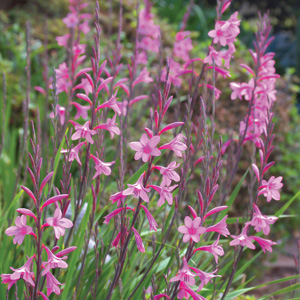Watsonia Growing Guide

What is Watsonia?
Watsonia also known as Bugle Lily, South African Bugle Lily or Watsonia Wordsworthiana is a large perennial herb that grows from corms. From the Iridaceae or iris family, it is native to South Africa. In Winter long strappy sword to reed like foliage is produced from the corm before the slender reddish flowering stems appear in Spring. There are quite a few different varieties of watsoina so flower colours vary from white, pink, peach, orange, red and lilac hues. The flowers will last may weeks attracting beneficial insects and birds to them. Late in Summer to Autumn the plant will begin to die off and go into dormancy. Watsonia thrive in full sun positions that are well drained.
Benefits of Growing Watsonia
Watsonia corms are not difficult to grow as they are very hardy and self sufficient. They look impressive as border plants or dotted amongst shrubs. They look best when planted in large clumps. Watsonia’s brightly coloured flowers attract birds and pollinating insects into the garden.
How to Grow Watsonia

Watsonia Lilac
Climatic Zones
Cool to subtropical
Plant Size
Height: 1m, Width: 30-40cm
When To Plant Watsonia
Plant in late Summer to Autumn.
Soil Preparation
They like fertile soil, preferably well drained but will put up with some water logging. When preparing your bed dig through a good amount of compost.
How To Plant Watsonia
Plant in full sun, 12cm apart with the corm 15cm deep under the soil.
Watsonia Plant Care
During watsonia’s growing period make sure you provide adequate water. Keep the soil moist.
Best left undisturbed and allowed to spread freely. Every few years it is important to divide clumps as their flowers begin to diminish each season. This can be done late Summer to Autumn. Make sure that when you cut up the corm that each piece has an eye and healthy roots. Replant by mixing through some compost.
Remove spent flowers at the end of the season however leave the leaves to continue to store energy for the next flowering season.
Fertiliser the plant during Spring with a bulb fertiliser.






